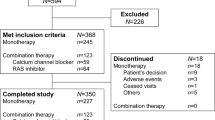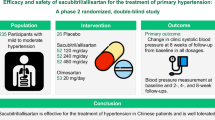Abstract
The antihypertensive efficacy of the angiotensin II receptor blocker olmesartan medoxomil has been shown to compare favourably with that of other antihypertensive agents. This randomized, double-blind study compared the antihypertensive efficacy of the starting dose of olmesartan medoxomil with that of the calcium channel blocker amlodipine besylate (amlodipine) in subjects with mild-to-moderate hypertension. Following a 4-week, single-blind, placebo run-in period, 440 subjects aged ⩾18 years were randomized to the starting dose of olmesartan medoxomil (20 mg/day), amlodipine (5 mg/day), or placebo for 8 weeks. Subjects were evaluated by 24-h ambulatory blood pressure monitoring (ABPM) and by seated cuff blood pressure (BP) measurements at trough. The primary end point was the change from baseline in mean 24-h diastolic blood pressure (DBP) by ABPM at Week 8. Secondary end points included change from baseline in mean 24-h ambulatory systolic blood pressure (SBP) at 8 weeks, change from baseline in mean seated trough cuff DBP and SBP measurements, and response and control rates for DBP <90 and <85 mmHg. Control rates for SBP <140 and <130 mmHg were also calculated. Olmesartan medoxomil and amlodipine produced significantly greater reductions in ambulatory and seated DBP and SBP compared with placebo. Mean reductions in ambulatory and seated BP were similar between the two active agents; however, in the olmesartan medoxomil group, significantly more patients achieved the SBP goal of <130 mmHg and the DBP goal of <85 mmHg. Both drugs were well tolerated at the recommended starting dose. Although amlodipine was associated with a higher incidence of oedema, this did not reach statistical significance. Olmesartan medoxomil is an effective antihypertensive agent, with BP-lowering efficacy at the starting dose similar to that of amlodipine, and is associated with more patients achieving the rigorous BP goals of SBP <130 mmHg and DBP <85 mmHg.
This is a preview of subscription content, access via your institution
Access options
Subscribe to this journal
Receive 12 digital issues and online access to articles
$119.00 per year
only $9.92 per issue
Buy this article
- Purchase on Springer Link
- Instant access to full article PDF
Prices may be subject to local taxes which are calculated during checkout



Similar content being viewed by others
References
Birkenhager WH, de Leeuw PW . Non-peptide angiotensin type 1 receptor antagonists in the treatment of hypertension. J Hypertens 1999; 17: 873–881.
Burnier M, Brunner HR . Comparative antihypertensive effects of angiotensin II receptor antagonists. J Am Soc Nephrol 1999; 10 (Suppl 12): S278–S282.
Neutel J . Safety and efficacy of angiotensin II receptor antagonists. Am J Cardiol 1999; 84: 13K–17K.
Neutel J . Clinical studies of CS-866, the newest angiotensin II receptor antagonist. Am J Cardiol 2001; 87 (Suppl): 37C–43C.
Stumpe KO, Ludwig M . Antihypertensive efficacy of olmesartan compared with other antihypertensive drugs. J Hum Hypertens 2002; 16 (Suppl 2): S24–S28.
Van Mieghem W . A multi-centre, double-blind, efficacy, tolerability and safety study of the oral angiotensin II-antagonist olmesartan medoxomil versus atenolol in patients with mild to moderate essential hypertension. J Hypertens 2001; 19 (Suppl 2): S152.
Oparil S et al. Comparative efficacy of olmesartan, losartan, valsartan, and irbesartan in the control of essential hypertension. J Clin Hypertens 2001; 3: 283–291.
Joint National Committee on Prevention, Detection, Evaluation, and Treatment of High Blood Pressure. The sixth report of the Joint National Committee on Prevention, Detection, Evaluation, and Treatment of High Blood Pressure. Arch Intern Med 1997; 157: 2413–2446.
American Diabetes Association. Treatment of hypertension in adults with diabetes. Diabetes Care 2002; 25: 199–201.
Bakris GL et al. Preserving renal function in adults with hypertension and diabetes: a consensus approach. Am J Kidney Dis 2000; 36: 646–661.
Osterloh I . The safety of amlodipine. Am Heart J 1989; 118: 1114–1119.
Frishman WH et al. Comparison of amlodipine and benazepril monotherapy to amlodipine plus benazepril in patients with systemic hypertension: a randomized, double-blind, placebo-controlled, parallel-group study. The Benazepril/Amlodipine Study Group. J Clin Pharmacol 1995; 35: 1060–1066.
Ekpo EB, Shah IU, Fernando MU, White AD . Isolated systolic hypertension in the elderly: survey of practitioners' attitude and management. Gerontology 1993; 39: 207–214.
Frick MH, McGibney D, Tyler HM . A dose–response study of amlodipine in mild to moderate hypertension. J Intern Med 1989; 225: 101–105.
Pitt B et al. Randomised trial of losartan versus captopril in patients over 65 with heart failure (Evaluation of Losartan in the Elderly Study, ELITE). Lancet 1997; 349: 747–752.
Pitt B et al. Effect of losartan compared with captopril on mortality in patients with symptomatic heart failure: randomised trial—the Losartan Heart Failure Survival Study ELITE II. Lancet 2000; 355: 1582–1587.
Lindholm LH et al, for the LIFE Study Group. Cardiovascular morbidity and mortality in patients with diabetes in the Losartan Intervention For Endpoint reduction in hypertension study (LIFE): a randomised trial against atenolol. Lancet 2002; 359: 1004–1010.
Dahlöf B et al, for the LIFE Study Group. Cardiovascular morbidity and mortality in the Losartan Intervention For Endpoint reduction in hypertension study (LIFE): a randomised trial against atenolol. Lancet 2002; 359: 995–1003.
Bloom BS . Continuation of initial antihypertensive medication after 1 year of therapy. Clin Ther 1998; 20: 671–681.
Kloner RA et al, for the Comparison of Candesartan and Amlodipine for Safety, Tolerability and Efficacy (CASTLE) Study Investigators. Comparative effects of candesartan cilexetil and amlodipine in patients with mild systemic hypertension. Am J Cardiol 2001; 87: 727–731.
Lacourciere Y et al. A comparison of the efficacies and duration of action of the angiotensin II receptor blockers telmisartan and amlodipine. Blood Press Monit 1998; 3: 295–302.
Corea L et al. Valsartan, a new angiotensin II antagonist for the treatment of essential hypertension: a comparative study of the efficacy and safety against amlodipine. Clin Pharmacol Ther 1996; 60: 341–346.
Oparil S et al. Efficacy, tolerability, and effects on quality of life of losartan, alone or with hydrochloro-thiazide, vs amlodipine, alone or with hydrochloro-thiazide, in patients with essential hypertension. Clin Ther 1996; 18: 608–625.
Hansson L et al. Effects of intensive blood-pressure lowering and low-dose aspirin in patients with hypertension: principal results of the Hypertension Optimal Treatment (HOT) randomised trial. Lancet 1998; 351: 1755–1762.
Hebert LA et al, for the Modification of Diet in Renal Disease Study Group. Effects of blood pressure control on progressive renal disease in blacks and whites. Hypertension 1997; 30: 428–435.
UK Prospective Diabetes Study Group. Tight blood pressure control and risk of macrovascular and microvascular complications in type 2 diabetes: UKPDS 38. BMJ 1998; 317: 703–713.
Acknowledgements
Sources of research support: Sankyo Pharma Inc.
Author information
Authors and Affiliations
Corresponding author
Appendix
Appendix
List of study investigators
James Adelman, MD, Greensboro, NC, USA
Michael Azorr, MD, Portland, OR, USA
Norse Bear, MD, Denver, CO, USA
Frederick Bieberdorf, MD, Austin, TX, USA
Scott Bleser, MD, Bellbrook, OH, USA
Rogelio Cattan, MD, Miami, FL, USA
Deanna Cheung, MD, Long Beach, CA, USA
Steven Chrysant, MD, Oklahoma City, OK, USA
Michael Doyle, MD, Birmingham, MI, USA
James Fulmer, MD, Jacksonville, FL, USA
Thomas Garland, MD, FACC, Lawrenceville, NJ, USA
Gumaro Garza, MD, McAllen, TX, USA
Larry Gilderman, DO, Pembroke Pines, FL, USA
Ronald Gilman, MD, East Providence, RI, USA
Stephen Green, MD, Hampton, VA, USA
William Grossman, MD, Charleston, SC, USA
Frank Hampel, Jr., MD, New Braunfels, TX, USA
Stuart Harris, MD, PhD, Miami, FL, USA
William John Henry III, MD, Greer, SC, USA
Jeffrey Herbst, MD, Portland, OR, USA
James Herron, MD, Chicago, IL, USA
Dean Kereiakes, MD, Cincinnati, OH, USA
Marc Kozinn, MD, Amherst, NY, USA
Andrew Lewin, MD, Los Angeles, CA, USA
Martin Lunde, MD, Arden Hills, MN, USA
Frank Maggiacomo, DO, Cranston, RI, USA
Thomas Marbury, MD, Orlando, FL, USA
David Miller, MD, North Dartmouth, MA, USA
Rafael Montoro, MD, Coral Gables, FL, USA
Joel Neutel, MD, Orange, CA, USA
Alan Niederman, MD, FACC, Ft. Lauderdale, FL, USA
Michael Peveler, MD, Louisville, KY, USA
Paul Ratner, MD, San Antonio, TX, USA
Albert Razetti, MD, DeLand, FL, USA
Dennis Ruff, MD, San Antonio, TX, USA
Stephan Sharp, MD, Nashville, TN, USA
Eugene Spiotta, Jr., MD, Memphis, TN, USA
Gary Andrew Tarshis, MD, Colorado Springs, CO, USA
Melvin Tonkon, MD, Anaheim, CA, USA
Timothy Truitt, MD, Melbourne, FL, USA
Suzanne Weakley, MD, Houston, TX, USA
David Williams, MD, Daytona Beach, FL, USA
Laurence Yellen, MD, San Diego, CA, USA
Rights and permissions
About this article
Cite this article
Chrysant, S., Marbury, T. & Robinson, T. Antihypertensive efficacy and safety of olmesartan medoxomil compared with amlodipine for mild-to-moderate hypertension. J Hum Hypertens 17, 425–432 (2003). https://doi.org/10.1038/sj.jhh.1001577
Received:
Revised:
Accepted:
Published:
Issue Date:
DOI: https://doi.org/10.1038/sj.jhh.1001577
Keywords
This article is cited by
-
Olmesartan medoxomil: a guide to its use as monotherapy or in fixed-dose combinations with amlodipine and/or hydrochlorothiazide
Drugs & Therapy Perspectives (2016)
-
Long-Term Efficacy of Olmesartan Medoxomil in Chinese Hypertensive Patients as Assessed by Clinic, Ambulatory and Home Blood Pressure Measurements
Clinical Drug Investigation (2012)
-
Olmesartan improves endothelial function in hypertensive patients: link with extracellular superoxide dismutase
Hypertension Research (2011)
-
Rationale, design and patient baseline characteristics of OlmeSartan and calcium antagonists randomized (OSCAR) study: a study comparing the incidence of cardiovascular events between high-dose angiotensin II receptor blocker (ARB) monotherapy and combination therapy of ARB with calcium channel blocker in Japanese elderly high-risk hypertensive patients (ClinicalTrials. gov no. NCT00134160)
Hypertension Research (2009)
-
Olmesartan ameliorates myocardial function independent of blood pressure control in patients with mild-to-moderate hypertension
Heart and Vessels (2009)



